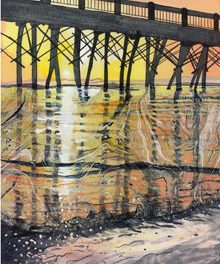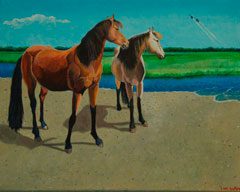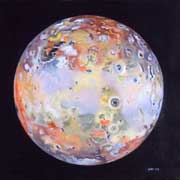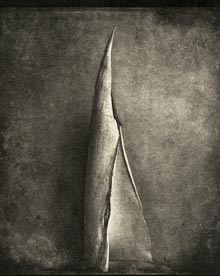 Fiber artist Kim Keats and fine-art photographer Gary Geboy
Fiber artist Kim Keats and fine-art photographer Gary Geboy 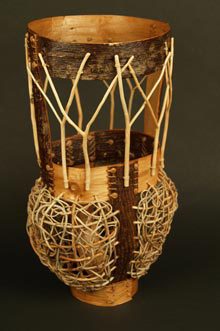 collaborate on a groundbreaking show at USCB.
collaborate on a groundbreaking show at USCB.
 Mark Shaffer: What was the genesis for this show?
Mark Shaffer: What was the genesis for this show?
Gary Geboy: Kim and I are interested in the same things. The materials she uses are the things I photograph. Her work is all hand done and a lot of my work, even though it’s photography is very hands on: the paper is hand made, the printing done by hand and I shoot on film. Also we like each other’s work immensely, so we thought hey it would be cool to have a show together.
MS: In essence you’re working with the same materials in different dimensions.
Kim Keats: Right. And we’ve collected each other’s work over the last four years or so. I think we both work within our disciplines by using combination methods and innovative methods.
GG: Exactly.
KK: I’ve been working in fiber construction specializing in basketry techniques. The way I use the techniques and even the materials I harvest are very different from the way other people working in the field are using them. I think you could say we’ve innovated or invented or at least used combinations differently than what’s standard in our field.
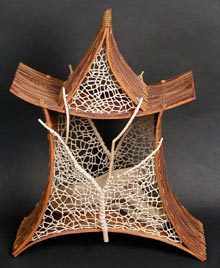 GG: I work mostly in platinum palladium – big negatives and big prints on specific types of paper. I’ve moved out of the normal types of paper and I use a lot of Japanese papers. One is made with fibers from a plant that only grows at around 5000 feet. So it’s pretty scarce to begin with, but the paper has this really beautiful sheen to it that a lot of standard papers don’t have. One of the other Japanese papers is made from a plant that’s completely sustainable and it’s very thin – almost translucent. It’s like a sponge. It soaks up everything. I’ve had to modify my techniques to use this type of paper because the paper itself creates a texture that you just can’t get in anything else.
GG: I work mostly in platinum palladium – big negatives and big prints on specific types of paper. I’ve moved out of the normal types of paper and I use a lot of Japanese papers. One is made with fibers from a plant that only grows at around 5000 feet. So it’s pretty scarce to begin with, but the paper has this really beautiful sheen to it that a lot of standard papers don’t have. One of the other Japanese papers is made from a plant that’s completely sustainable and it’s very thin – almost translucent. It’s like a sponge. It soaks up everything. I’ve had to modify my techniques to use this type of paper because the paper itself creates a texture that you just can’t get in anything else.
MS: What’s the correlation between the two mediums?
KK: I think we both have this incredible regard for materials, particularly sustainable materials, and our imagery is significantly determined by the materials we use. There’s a sort of dialogue between the materials. I’m an object maker and tend to refer to my works as objects rather than images, although there is imagery in them. Much of my work is about showing my love and appreciation for the material and the forms that I make reflect that.
I’m doing a lot of work with palmetto root, and as far as I know no one in my field is working with palmetto root. Largely that’s because you have to harvest it from a tree that’s overturned on an  eroding beach where there are palmetto trees and there’s not a lot of that. What comes from it is determined by what I’m able to make the material do. I hope for a dialogue between me and the material to create these images which tend to be vessels and architectural shrine-like forms. I also work with tree bark that I harvest and drift wood – upland and lowland materials. I get the driftwood here and the bark comes mostly from the north Georgia mountains. The tree is my metaphor. Nearly everything I work with comes from trees. The tree just seems to me to be this universal metaphor for life.
eroding beach where there are palmetto trees and there’s not a lot of that. What comes from it is determined by what I’m able to make the material do. I hope for a dialogue between me and the material to create these images which tend to be vessels and architectural shrine-like forms. I also work with tree bark that I harvest and drift wood – upland and lowland materials. I get the driftwood here and the bark comes mostly from the north Georgia mountains. The tree is my metaphor. Nearly everything I work with comes from trees. The tree just seems to me to be this universal metaphor for life.
GG: Could you make paper out of palmetto root?
KK: You might try. Maybe you could pound it to a pulp.
GG: Yeah, that might save a few bucks.
(Laughter)
MS: It’s the next logical step. I’m guessing that Japanese paper is a bit pricey, particularly the one made from the plant that only grows at a certain altitude.
GG: Yeah and the thing about that is there was only one guy who made it and he died last year. Now it’s really hard to come by. The price just skyrocketed over night.
KK: So you have to be perfect when you print.
MS: Not a lot of room for error in an already expensive process.
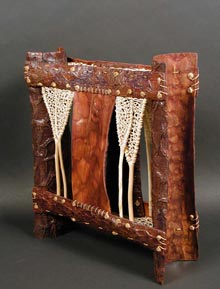 GG: This year the cost of platinum palladium doubled. Paper is only going to go up in price, no matter what kind it is. I also work in gold leaf and gold’s at an all time high. I work in all these materials that have such an expense and value but they’re all organic and they’ll last a long time.
GG: This year the cost of platinum palladium doubled. Paper is only going to go up in price, no matter what kind it is. I also work in gold leaf and gold’s at an all time high. I work in all these materials that have such an expense and value but they’re all organic and they’ll last a long time.
Sometimes I look at all this and go what the hell am I doing? Because this is ridiculous, you know? It’s so expensive it’s just crazy and then people look at it and most don’t know the difference.
MS: But there’s no way you could get the same texture and depth from a digital process.
GG: You couldn’t, but there are some people who say you could. You might come close if you tried. But the difference is that one was created all within the context of a machine on a computer screen with a click. You push a button and out it comes. The other one is made purely by hand and I think that element sets it apart.
KK: I think that’s another common thread, too.
MS: This brings us right back to the theme of Organics.
KK: It does. I think we both have that connection. We’re also both willing to invest the time. I have pieces that I’ve easily spent 200 hours on.
GG: Wow.
MS: Another connection among the materials you both use is an apparent fascination with the dead. I know from personal experience that [Gary] collects…
GG: Dead things.
(Laughter)
KK: Yes. If the cops ever show up at my house… I have no idea what some of my bones are. I don’t know what they might find in the collection.
(Laughter)
MS: Perhaps a few unsolved crimes?
(Laughter)
KK: Some people might think there’s something a bit off about collecting bones, but I find them so beautiful. As a painter I love Georgia O’Keefe’s work so it’s only natural that I’d go from admiring someone’s paintings of bones and skulls to collecting them and using them in my work. I’ve used bones, turtle shell, parts of armadillos – in fact the image we’re using on the invitation is actually an armadillo. Some of the driftwood I collect often looks very bone-like, like those of a tree.
MS: Kim’s termed her work with these materials as “salvaging.” Gary, you prefer “scavenging”?
GG: I scavenge. When nature begins to take its course, at some point I interrupt that process. If it’s a bone or a particular kind of dried vine, whatever you can find lying around outside that isn’t man made, those are the things I collect and I’ve been collecting those things all my life. I find as much majesty in those little things as anybody would in the Grand Canyon or the Rocky Mountains. The backyard is full of these things and they go through people’s lives unnoticed. Leaves fall and then they’re gone. I like to take a piece of that and interrupt its deterioration and then photograph it so that I get a particular image that might be all around you that you never see. Then whatever it is usually goes back in the yard or I put it in a box. Sometimes, as it continues to deteriorate, I’ll photograph it again and it’s completely changed. I interrupt the process with a photograph.
MS: Kim, you’re doing something similar yet different. While Gary’s interrupting the process you are suspending it.
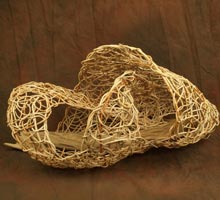 KK: I’m suspending it and capturing it. I consider these things Nature’s relics and hold them in the same regard as any relic a human would make, so I find a way to preserve it. This means that sometimes I have to treat it with a stain or a finish – alter it a little to preserve it – and then make it part of the image. Then the form that it goes into becomes about that little relic that’s been found, even though it might occupy a tiny portion of the whole piece. It becomes the reason why this form was constructed.
KK: I’m suspending it and capturing it. I consider these things Nature’s relics and hold them in the same regard as any relic a human would make, so I find a way to preserve it. This means that sometimes I have to treat it with a stain or a finish – alter it a little to preserve it – and then make it part of the image. Then the form that it goes into becomes about that little relic that’s been found, even though it might occupy a tiny portion of the whole piece. It becomes the reason why this form was constructed.
MS: This has to provoke some strong reaction occasionally.
KK: Most people don’t usually react negatively to it, but most don’t know what to do with it because they think they have to do something with it. They’ll ask me what [the piece] is supposed to be. I do a lot of vessels but most are anti-vessels…
GG: What? They don’t hold change?
(Laughter)
KK: They’re not intended to hold stuff but people always ask, “What can I put in this?” I always answer – rather smugly, I’ll admit – “Space. Just space.”
GG: The other side of that is not “What do I do with it?” – it’s “I’m looking at something and it’s just that thing.” Big freaking deal. So what? It’s not part of a grand theme. It’s not something you have to step back to take in.
MS: But it is a grand theme – it’s life and death. It doesn’t get much grander.
KK: I like that.
GG: Some people say that. Absolutely. My challenge is how I present it so that it’s more interesting… so that you can’t just look at it and say, “Big deal.” I have to present it in a certain way so that people are forced to look at it – that it’s so beautiful or bizarre that they have to look at it.
MS: The USCB Center for the Arts seems a great venue for this show.
KK: This is where you really want a body of your work to be seen.
ETCETERA
Organics: The Art of Nature opens Thursday, January 12th at the USCB Center for the Arts. The public is invited to an opening reception from 6 – 8 pm.
Go to lcweekly.com for the expanded version of this interview. Email Mark Shaffer at backyardtourist@gmail.com

